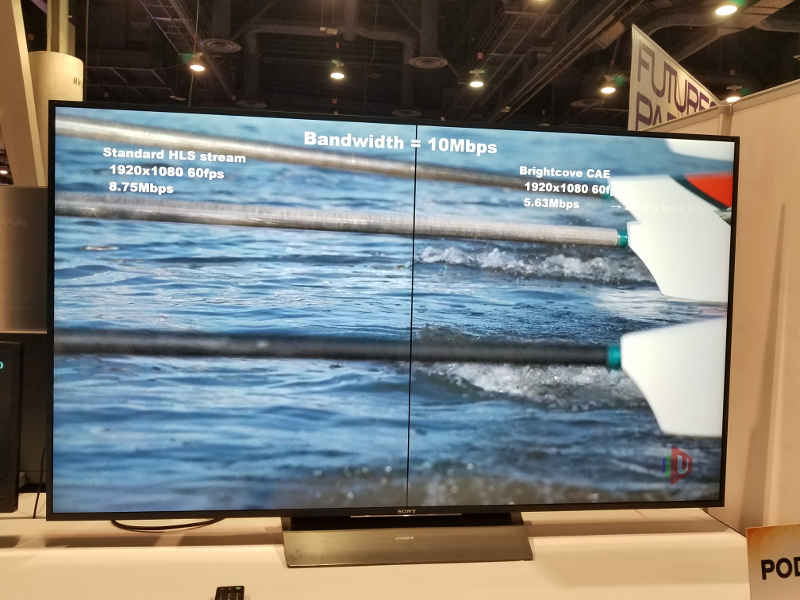The UHD Forum teamed up with the UHD Alliance in the Futures Park area. The two groups are collaborating for the first time. This is partly motivated by the maturing of UHD and some overlap in mission, but also the fact that the organizations share common corporate sponsors who want to see some efficiency in their efforts in these two groups.
We met with Theirry Fautier, who works for Harmonic but it also the President of the UHD Forum. On Saturday, he had given a detailed presentation on the state of the UHD roll out (which we did not attend) and the release of the new Phase B Guidelines (covered elsewhere). Fautier said that UHD is rolling out nicely but there are not a lot of HDR channels yet.
The Forum is focused on making sure the Phase A guidelines are rolled out well, which focuses on HLG and HDR10 distribution of HDR content. They have identified 52 services for UHD content but only 27% (14) services are offered in HDR today.
We asked about HD HDR and Fautier said there has been a lot of talk about the better economics of HD HDR, but so far, there have been no deployments. He agrees that adding HDR to HD rather than simply moving from HD to UHD is a better value proposition, but it is not being adopted.
A recent unofficial survey of the TVs for sale in a Dixons store in the UK showed that 63 of the 69 sets on display supported HDR – either PQ and/or HLG. (which, of course, means that they understand PQ or HLG, but not, necessarily, that they deliver a good HDR experience – Man. Ed.)
For 2018, the demos mostly focused on Phase B technologies including dynamic metadata, next generation audio, content aware encoding and high frame rate. For example, the Universal HDR display was a streaming demo of the Technicolor/Philips HDR solution called SL-HDR1. This encodes an SDR signal with 10-bit HEVC plus metadata for distribution to SDR or HDR TVs. The metadata allows the reconstruction of the HDR signal on HDR-capable TVs, or the display of SDR on SDR TVs. This sounds good, but SDR TVs typically don’t decode HEVC and want an 8-bit signal, so this is really not backward compatible. A Dolby Vision dynamic metadata solution was also showcased. Dolby Vision uses a 10-bit HEVC HDR10 encode as a base layer with dynamic metadata embedded in an enhancement layer.
There was a demo of the advantage of 100 fps display vs. 50 showing the reduced motion blur. This has only become possible commercially in 2018 as the LG OLED TV support native display of content at 100/120 fps. Examples of tennis and hockey showed the obvious advantages.
Content aware encoding was also demonstrated, where. as the name suggests, the encoding parameters are adjusted based on the content being shown. On display was an example of an implementation from Brightcove vs. a standard HLS stream that showed a reduction from 8.75 Mbps to 5.63 Mbps for 1080/60 content. In addition to reducing bandwidth, the encode is said to improve Quality of Encoding as well and can now be extended to live broadcasts.

Also on display was a side-by-side audio demo to showcase AC-4 (developed by Dolby) vs. MPEG-H (developed by Fraunhofer HHI) immersive audio formats. Both have been approved for use in ATSC 3.0, but will be selected and deployed on a regional basis (North America and Italy have chosen AC-4 whereas France and Korea are going with MPEG-H). Both formats offer very similar features including selection of languages, subtitles, and audio tracks to personalize the experience (for example, turning up/down the audience sound at a sporting event).
Mike Zink from the UHD Alliance said that their group is now adding recommendations for content creation and playback. In essence, the recommendations are to follow the ITU and SMPTE standards that are already in place, so nothing really unexpected. For example, ITU-R BT 2390 is a live HLG production (OOTF system gamma to equal 1.2, 1000 cd/m² peak luminance and HLG-PQ cross conversions)

The UHD Alliance is also working on interoperability testing. That is, they are plugging together a lot of TVs, set top boxes, AVR receivers and more to see what does not work well. They are finding a lot of issues, so are working with manufacturers to resolve these to improve the end user experience. – CC

